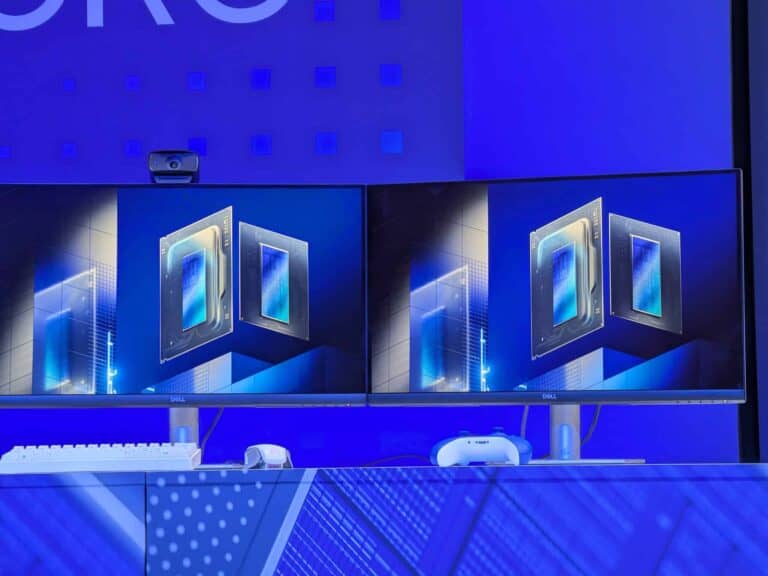The long-awaited Arrow Lake architecture now powers Intel’s latest desktop and laptop processors. While it marks the first appearance of an NPU on desktop chips, it’s using an older variant. But how significant is this really?
While there’s been endless discussion about the AI PC, Intel brings us back to fundamentals. As Josh Newman, GM & VP of Product Marketing & Management for the Client Computing Group, puts it: “a good AI PC begins with a good PC.” Intel’s presentation of Arrow Lake, which powers the Intel Core Ultra 200S lineup, reveals a more comprehensive approach than we’ve seen in recent months. Simply discussing the introduction of AI PCs alone no longer suffices.
Intel unveiled Arrow Lake’s capabilities just before IFA in Berlin—the same event where Lunar Lake, designed for thin-and-light laptops, was launched. The “moonshot” Lunar Lake has been well-received so far. In the AI PC space, Intel, Qualcomm, and AMD are all formidable competitors. But does this competition extend to desktop AI PCs, where AMD stands as the sole challenger?
Hint: Without artificial constraints, the desktop AI PC has existed for years
An overview of all recent “Lakes”
| Release date | Name | Laptops? | Desktops? | Series name |
| 4 Nov 2021 | Alder Lake | Yes | Yes | Core 12000 |
| 20 Oct 2022 | Raptor Lake | Yes | Yes | Core 13000 |
| 17 Oct 2023 | Raptor Lake (refr.) | Yes | Yes | Core 14000 |
| 14 Dec 2023 | Meteor Lake | Yes (thin-and-light) | No | Core Ultra 100 |
| 24 Sep 2024 | Lunar Lake | Yes (thin-and-light) | No | Core Ultra 200V |
| 24 Oct 2024 | Arrow Lake | Yes | Yes | Core Ultra 200S |
Strange choices (at first glance)
There’s a clear reason why Intel is downplaying the AI PC angle for the Core Ultra 200S: it features an older NPU—specifically, its NPU 3. This chip was already present in late 2023’s Meteor Lake, which has since been superseded by Lunar Lake with its much more powerful NPU 4. While we’re consistently told that TOPS shouldn’t be the standard measure for on-device AI performance, Arrow Lake’s specifications remain modest. The lack of NPU advancement compared to last year’s laptop-bound capabilities is notably disappointing.
While a thin-and-light Intel Core Ultra 200V (Lunar Lake) achieves up to 120 TOPS combining NPU, GPU, and CPU performance, a mobile Intel Core Ultra 200S (Arrow Lake) reaches only 99 TOPS. The desktop version maxes out at just 36 TOPS through the same combination. Intel’s position is that this shouldn’t be a major concern, as users requiring serious AI performance likely have a discrete GPU available.
This assumes Microsoft’s cooperation. As the gatekeeper of Copilot+ PCs (essentially “true” AI PCs supporting all Windows Copilot features), Microsoft has already excluded Meteor Lake laptops from most local AI workloads in Windows 11. With Arrow Lake, there’s hope that GPUs will be allowed to handle tasks like Windows Recall; otherwise, Intel’s latest offering risks being outdated at launch.
Bigger targets
Taking Intel’s perspective, we should consider the Core Ultra 200S series from a broader vantage point. This new generation of desktop and laptop processors primarily aimed at delivering strong performance with significantly improved efficiency. Intel hopes this will finally allow them to offer high-end processors that aren’t plagued by concerning voltage levels and stability issues.
Many Core Ultra 200S features focus on current standards. Wi-Fi 6E, Thunderbolt 4, PCIe 5.0, and DDR5 support (up to 6400 MT/s) are key features, while a new security engine provides enhanced data protection.
The Compute Tile includes up to 8 P-cores and 16 E-cores, handling all conventional computing tasks. The Lion Cove P-cores show a modest 9 percent IPC improvement, while the Skymont E-cores demonstrate more substantial gains. Single-threaded workloads see up to 72 percent higher IPC, with multi-threaded performance improving by up to 55 percent.
This represents Intel’s real achievement and Arrow Lake’s primary purpose. Following Meteor Lake’s laptop debut last year, this architecture demonstrates that Intel has addressed previous attacks on its lack of efficiency and power-hungry products. This response may well silence many current Intel critics.
Adoption
Intel now offers processors with integrated NPUs across all client systems. Thin-and-light devices feature the most specialized solution with Lunar Lake. This niche appears particularly important to Intel, while Arrow Lake is less ambitious for standard laptops and desktops, essentially providing a conventional Raptor Lake update. Arrow Lake’s success largely depends on factors beyond Intel’s control, particularly Microsoft’s willingness to enable AI capabilities on desktop PCs. This requires approval for AI workloads on GPUs where technically feasible—which is nearly always.
The naming scheme has become somewhat confusing, which is weird considering Intel’s very recent numbering reset. Meteor Lake initiated a new “generation 1” under the Intel Core Ultra brand. Now that the 13th and 14th generation Raptor Lake chips have been replaced by Intel Core Ultra 200S, another reset aligns with the distinct Lunar Lake series. Core Ultra 200V represents Lunar Lake for thin-and-lights, while Core Ultra 200U, 200K, 200H, and 200HX chips all use Arrow Lake with varying specifications and scaling.
While this naming convention seems unnecessarily complex, it’s a minor concern when considering Intel’s broader strategy. For the first time in years, Intel has truly refreshed every market segment they serve. However, celebration may be premature: as mentioned, software support remains crucial.
More critically, we’ve seen Intel appear to be on the right track before. With Alder Lake in 2021, Intel debuted its first architecture combining both large and small cores, designed for performance and efficiency respectively. While Intel maintains this approach, subsequent Raptor Lake processors returned to excessive power consumption and temperatures. With AMD competing across all segments, Intel can’t afford to lose focus this time.
Also read: Intel launches Core Ultra 2, the answer to Qualcomm and AMD
